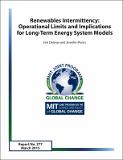Renewables Intermittency: Operational Limits and Implications for Long-Term Energy System Models
Author(s)
Delarue, E.; Morris, J.
DownloadMITJPSPGC_Rpt277.pdf (1.761Mb)
Metadata
Show full item recordAbstract
In several regions of the world, the share of intermittent renewables (such as wind and solar PV) in electricity generation is rapidly increasing. The current share of these renewable energy sources (RES) can still more or less be handled by existing systems and flexibility, benefiting from remaining excess capacity of dispatchable (backup) generation and links to other grids that can balance the intermittency. However, often higher levels of intermittent RES are envisaged for the future, posing significant challenges on system operation and planning. In assessing possible energy futures, long-term energy system models are typically used. The representation of RES in such models needs careful attention, as intermittent RES come with a number of specific characteristics, making them different from conventional dispatchable generation. This paper focuses on technical implications related to systems trying to achieve high shares of renewable electricity. The relevance of demand and RES generation profiles are demonstrated. After some threshold, a sharp decreasing relationship between installed RES capacity and marginal contribution in terms of generation is identified; therefore, even with perfect backup, a technical limit exists on achievable RES shares. The impact of RES on net demand peak reduction is also addressed. In the absence of system flexibility, substantial backup is required to ensure reliable electricity provision. The role of different flexibility instruments is explored and is found to be significant. Reflections are provided on options to include these aspects in long-term energy system models.
Date issued
2015-03Publisher
MIT Joint Program on the Science and Policy of Global Change
Citation
Report 277
Series/Report no.
MIT Joint Program Report Series;277